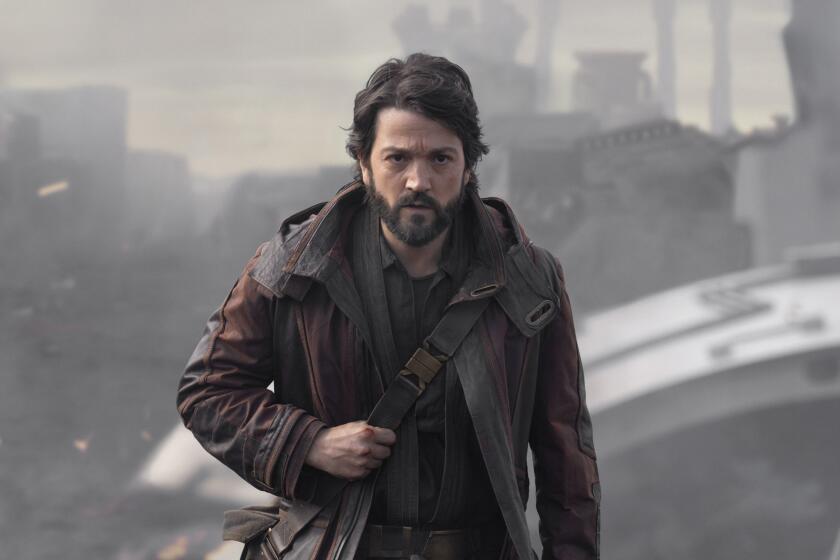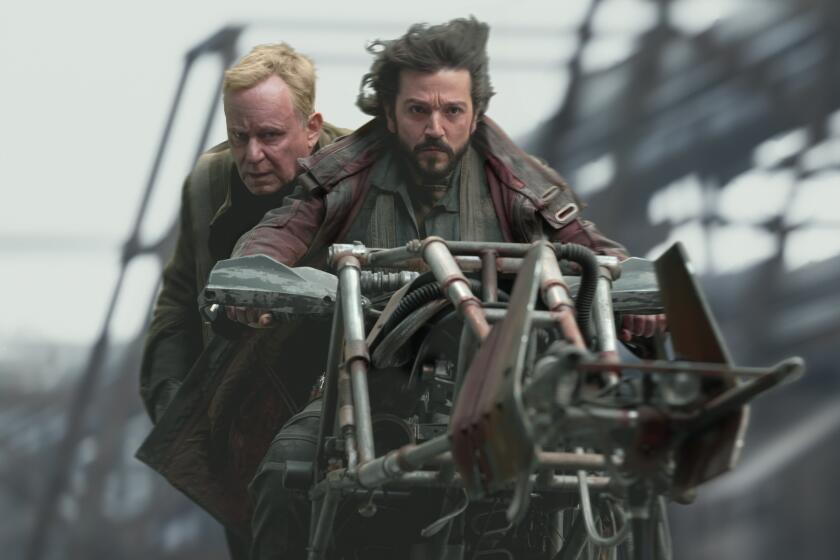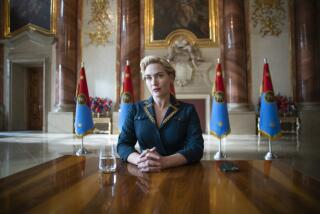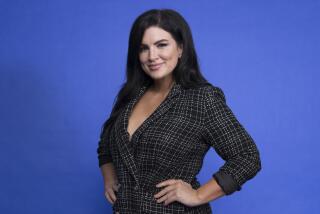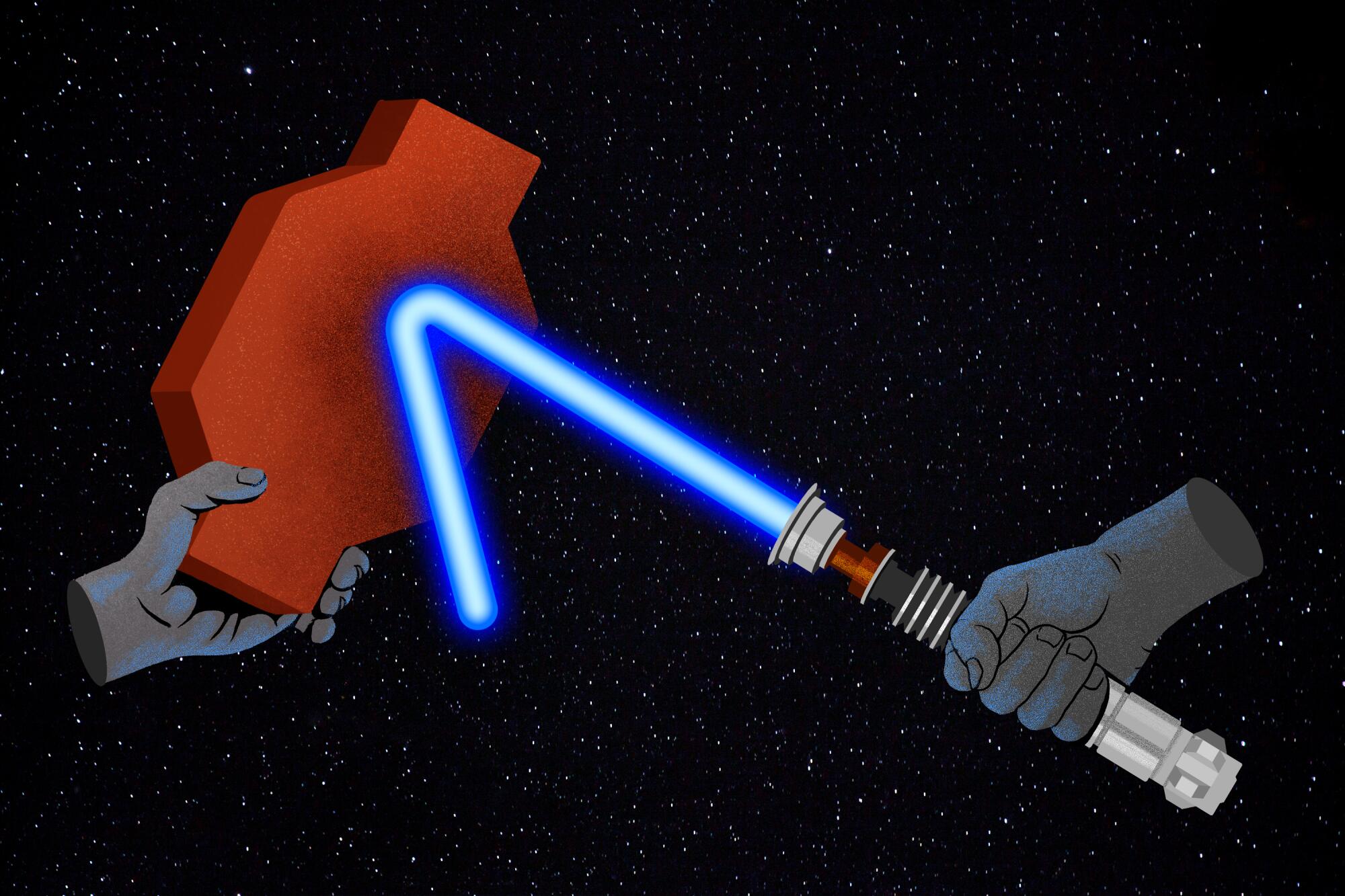
Last week, audiences hailed the season finale of “Andor” on Disney+, which tells the backstory of “Star Wars” rebel Cassian Andor (played by Diego Luna).
Times writers Tracy Brown, Matt Pearce and Jamil Smith sat down to talk about why the first season of the political-espionage drama is one of the best “Star Wars” stories ever made.
Tracy Brown, “Star Wars” weirdo: It’s no secret that I had high hopes for “Andor.” The “Star Wars” series was one of my picks for The Times’ list of most anticipated fall shows, largely based on my love for “Rogue One,” the 2016 prequel film that told the story of just how the Rebel Alliance got those Death Star plans to begin with. But the series more than exceeded my expectations by daring to go where no “Star Wars” has gone before: showing us how ordinary people become radicalized. I’ve already written about how one of the things that makes “Andor” great is because it is unabashedly political, and its politics make the galaxy far, far away feel as relevant and exciting as ever.
Matt, I mean this in the best way, but you are probably one of the last colleagues I expected to hear from about a “Star Wars” series. What did you make of “Andor”? Did it make you see “Star Wars” differently than you had before?
Matt Pearce, “Star Trek” weirdo: I’m a “Star Trek” guy because that franchise spends so much time on its politics. The big crisis in most Trek series is how liberal democracy’s values hold up when confronted with (very) foreign cultures with their own values. A happy ending isn’t overthrowing the government, it’s normalizing diplomatic relations with your adversaries and building a permanent peace. It’s all just the story of Francis Fukuyama’s “End of History” and the triumph of liberalism over and over again. The thing that always bugged me about “Star Wars” is that I just did not get the politics.
Tracy: The Force is the politics.
How a prequel of a prequel, starring Diego Luna as future Rebellion spy Cassian Andor, became the jewel in the crown of ‘Star Wars’ television.
Matt: I like sword fights, but I was always like, “Wait, how did the Empire build all this stuff?”
Tracy: Now we know it’s prison labor.
Matt: “Andor” gives the “Star Wars” universe a different political story, one we’re all familiar with. The heroes are exploited workers with only one way out; the villains are the upwardly mobile bourgeoisie who like the system the way it is. Jamil, as a fan of both franchises, why do you think “Andor” can pull in outsiders like me, and what makes this “Star Wars” franchise so different from the others?
Jamil Smith, hybrid “Star Trek”/”Star Wars” weirdo: For one, it may be because “Andor” feels more like “Star Trek.” There is a verisimilitude in the latter that “Star Wars” can never match. The Skywalkers are from Alderaan and Tatooine, while James T. Kirk is from Iowa. For all its futuristic doodads and wide array of alien life, “Trek” is certainly set in the universe that we occupy — and not “a long time ago, in a galaxy far, far away.”
The irony, though, is that the story “Star Wars” has been telling has always been more relatable. Our natural state as human beings seems inclined towards self-destruction and conflict, and “Star Trek” rebels against this. It presents an optimistic destiny for humankind, one that gets more utopian and cooperative the further it looks into the future. However, our current dystopia may have reached a point where a story about space fascists is more relatable.
Tracy: I hear you on our current dystopia, but the space fascists from the original trilogy were also based on actual 20th century fascists.
Jamil: There are the unmistakable allusions to World War II, of course. Stormtroopers wear Totenkopf skulls for helmets and borrow their name from Hitler’s shock troops. The Imperial uniforms are a sartorial nod to the Nazi costume. Darth Vader’s helmet evokes both Japanese samurai and the German Stahlhelm helmets worn by the Wehrmacht. The degree to which Hitler was intrigued by the occult is up for debate, but it’s inarguable that the Empire uses the mysticism of the Dark Side to lord over the worlds they oppress. That all said, George Lucas himself once said that Emperor Palpatine was inspired by President Richard Nixon. For Americans, the “Star Wars” story doesn’t just reflect malevolence abroad.
Those all were signposts from the past, helpful for a moviegoing audience looking for a clear delineation between good and evil. Perhaps more than any “Star Wars” story told prior to this, “Andor” understands and reflects our current reality. It bases a contemporary insurrection narrative within a context we can recognize. As Tracy was mentioning before, there is the exploitation of prison labor. We have senators, mechanics, construction workers and society elite, all working to subvert a fascist dictatorship. We see the sometimes fatal compromises and sacrifices that revolutionaries feel they must make in order to keep the rebellion going.
Matt: There’s a lot of means-ends calculating going on here.
Jamil: It would be swell if a band of galactic warrior monks could have stopped the Nazis, or were available today to head off rising fascism around the world. But that is not the reality of a rebellion.
I’m curious, Tracy, how you feel about how the character of Cassian Andor fits into all that. For this series, set five years before “Rogue One,” the filmmakers had to essentially devolve his character so that we could understand why the Rebellion means everything to him in the film. How do you think they did with his characterization?
Tracy: Cassian (played with steely resolve by Diego Luna) is your everyman and it’s one of the reasons the show is exceptional. Audiences know the version of Cassian that’s willing to die for the cause, so giving him a journey that makes his story compelling even though we all know how it ends is one of “Andor’s” core challenges.
The series gives Cassian both a very unique and very “Star Wars” backstory. That he’s an adopted orphan is very “Star Wars.” But he’s a refugee from a lush planet exploited for its natural resources by outsiders until it became uninhabitable — that’s not only unique, but it’s very grounded and topical.
Matt: Environmental despoliation appears multiple times in “Andor.”
Tracy: And pre-Rebellion Cassian is also cut from a very recognizable mold. Just about every other generation of young adults are described as “disaffected” at some point, with observations highlighting their cynicism towards institutions and pessimism about their futures. That’s the Cassian we meet when the show starts, someone who you (understandably) would not expect to become a radicalized leader.

It’s not just details from Cassian’s life that feel very contemporary. As we’ve already mentioned, we get a good glimpse of how the prison industrial complex operates. I never expected “Star Wars” to actually touch on the link between capitalism and authoritarianism beyond the wink we got in the prequels or how rebellions may feed on ideals but cost actual money. What are the details that struck you, Matt? What are the things that made “Andor” more exciting for you than your previous brushes with “Star Wars”?
Matt: I’m a real sicko for the tense department meetings and jockeying lackeys we see in “Andor,” the glimpses of the massive imperial bureaucracy. One of the observations Anne Applebaum makes in her book “Twilight of Democracy” is that modern authoritarian regimes have an elite cadre of college graduates and professionals doing all the real work of dictatorship behind the scenes. “Andor” shows us the complicity machine propping up Palpatine, who never appears on camera, because he doesn’t need to.
Tracy: Thank the Maker for that!
‘Andor’ showrunner Tony Gilroy talks about his Disney+ ‘Star Wars’ series, Diego Luna, creating Syril Karn and Dedra Meero and what to expect in Season 2.
Matt: “Star Wars” has always been cheeky about featuring Imperial middle managers (Darth Vader, Kylo Ren, Dedra Meero) whose competence is constantly thwarted by the morally corrupt system they’ve pledged loyalty to. In “Andor,” Meero and Syril Karn can’t find Cassian because they didn’t realize the Empire had already imprisoned him. Their dumb beach Nazis had already wrongly arrested Cassian on that resort planet for something he didn’t do! Nobody had bothered to figure out Cassian’s real name because the Empire’s bosses needed more slave labor to build the Death Star. “Andor” is subtle enough to show that it’s this sort of rot, not the Jedi, that topples governments.
For the rebels, the real revolutionary power is in the streets. The most iconic weapon in “Andor” isn’t a lightsaber, it’s a brick.
Tracy: That brick really got me.
Jamil: I think the issues they’re addressing are even more contemporary than the prior incarnations of “Star Wars.” The infrastructure not just of budding fascistic imperialism, but also a rebellion, in a increasingly technical age… that’s the story of this time. Of today. Also, while mass incarceration has always been an American problem, it has metastasized within our lifetimes.
Tracy: Yes, I was going to say the prison issues are still relevant now.
Matt: There’s a lot more surveillance paranoia in this one, no?
Jamil: A lot more. The show displayed a number of ways cultural expression can manifest as civil disobedience. We have to talk about the monologue lifted from the manifesto written by that young Rebel whom Cassian worked alongside for the heist. And the Andy Serkis character (Kino Loy)… whew. I felt like I was watching “Shawshank” by way of “Star Wars,” in a good way. Man was institutionalized!
Matt: Playing by the rules of a rigged game. The labor organizer Jane McAlevey has this great argument in one of her books about how sometimes the best union leaders are the ones who start out in strongest opposition, only to later realize their loyalties have been in the wrong place. It’s amazing that one of the most exciting battles in “Andor” doesn’t involve any X-Wings. It’s a work stoppage.
Jamil: It’s definitely relevant here. It was fascinating to see how he used the same power he had to lord over his fellow incarcerated men to rally them. And no one uses the Force! It makes sense that there wouldn’t be conspicuous Jedi hanging around, but I do love how the only people called upon to perform any sort of magic are crooked financiers.
Matt: OK, Trekkie question here, but: isn’t the Force something that’s inherited? It feels very monarchical.
Tracy: It’s not necessarily inherited.
Jamil: Precisely.
Tracy: The Force is in everyone and everything.
Jamil: But as with any form of mysticism, there are people who are more sensitive to it than others. I liken it to how some people claim to see ghosts and are, in other ways, more sentient of the paranormal.
Matt: Hear me out, but the only Force in “Andor” is class consciousness, and the plot is about how Cassian learns to use it. Some are sensitive to it and others aren’t.
Tracy: And some people will tell you it doesn’t exist.
Jamil: That’s just it, though: the show marks a fascinating point in that particular galaxy’s history. As a senator during a dictatorship, Mon Mothma sees the Republic fading away before her eyes. As she pleads to get the increasingly irrelevant Senate to push back on the Emperor’s authoritarianism through the legislative process, even she knows politics can’t be the answer.
What is “Andor”? Who is Cassian Andor? Everything you need to know before watching the new series, premiering Wednesday on Disney+.
Tracy: Yes, and I think that’s another detail that ties it to politics today. How long do you keep toiling away trying to work within a flawed and ineffective system?

Jamil: On both sides, we see people struggling to work within the system to change it. They either are pushing towards or against the Emperor. On the pro-fascism side, there were those two corporate climbers — the efficiently evil Imperial officer Dedra Meero and Syril Karn, the corporate security guard who looks one more bowl of blue cereal away from turning into Travis Bickle. On the other side? Folks like Luthen, Mon and Saw Gerrera, all of whom have clashing strategies on how to free the Republic.
Matt: It’s order versus justice.
Jamil: And Cassian represents, I think, the people who think simply opting out of the system protects them. And the series shows how he realizes that isn’t a productive or reasonable path.
Matt: One of the scenes that keeps sticking with me is where Luthen gives that speech to the Imperial double agent about why he’s so cold-hearted. He uses this sort of Lacanian imagery about the ego and the mirror, which I suspect is the first time we get something in the “Star Wars” franchise that’s basically psychoanalysis. He’s not on a hero’s journey to self-realization like Cassian. Luthen already knows exactly who he is and doesn’t need to discover anything new about himself. He drew up a formula for revolution a long time ago and is just doing the algebra of manipulating people and events to complete the equation. It’s the same kind of cold-hearted spreadsheet utilitarianism the Empire uses, which is why he seems so tortured and sure of himself at the same time.
Tracy: That speech is basically “Andor’s” thesis. That and Nemik’s manifesto.
Matt: Nemik is campaigning in poetry while Luthen governs in prose.
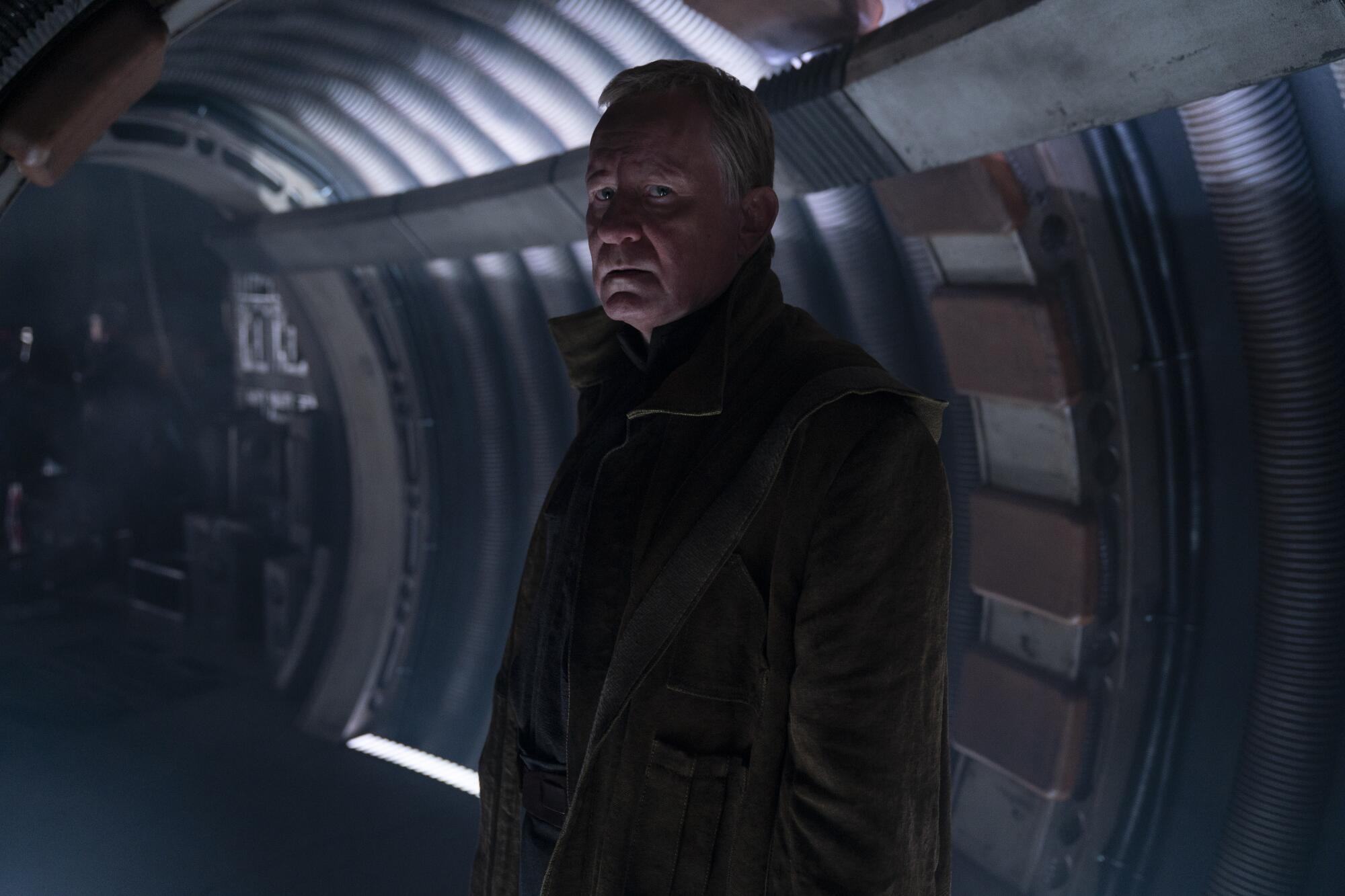
Tracy: Oh, and Maarva. There is no shortage of good speeches in the latter episodes of the season.
Jamil: Indeed, and none of them were pleading for help from the magical space wizards with the lightsabers. Especially in the wake of the “Obi-Wan Kenobi” limited series, which had the Force coming out of its pores, it was nice to see something about the actual wars in the stars.
I wonder sometimes what I would have thought of the original trilogy, had I not seen it all before I was 8 years old. At that age, I was begging my father to make me a real lightsaber with the genuine expectation that was something that could happen. I was obsessed with the Jedi part of the story, and now as an adult, I see them as an albatross. Disney, in particular, has oversaturated the Jedi storyline. Five new movies, and they still made it all about the Skywalkers and the Palpatines.
Tracy: This is why “Last Jedi” and “Rogue One” are arguably the best “Star Wars” movies post-Disney acquisition. I’ve said this before, and I will keep saying it, we can’t all be chosen ones and we shouldn’t only tell chosen one stories.
Jamil: Hard to argue against that. I’ll sing the praises of “Rogue One” for a moment. It has the great Vader cameo and a Force-sensitive Rebel on the quest — but that movie worked because it was about the mechanisms of war. Pardon the pun, but it recognizes that the return of the Jedi alone won’t win the war.
Tracy: True, but I do still understand the appeal of the Force and the Jedi. Even “The Mandalorian” couldn’t escape it, though they appear to be going deeper into Mandalore lore for Season 3, so theoretically less Skywalkers.
Jamil: Thank goodness. I know I’m in the minority here, but they overdid it with Grogu. I have a heart, but it just centered the Force and the Jedi order all over again. I hope “Andor” doesn’t make the same mistake in its second season and make the red droid some easily merchandisable sidekick.
Matt: Baby Yoda is so cute, though.
Jamil: Bah, humbug.
Matt: I know we’ve been having a very intelligent conversation about the political maturity of the “Star Wars” universe, but the closest I got to getting misty in “Andor” is when the robot got sad about Maarva’s death. This is Disney using the Force strangle on me. The Force strangle of cuteness.
Jamil: Sentimentality is a good weapon to wield, but it’s most effective when used sparingly. With “Andor,” Disney would be wise to learn from its own success. We’ll see if it does.
More to Read
The biggest entertainment stories
Get our big stories about Hollywood, film, television, music, arts, culture and more right in your inbox as soon as they publish.
You may occasionally receive promotional content from the Los Angeles Times.

